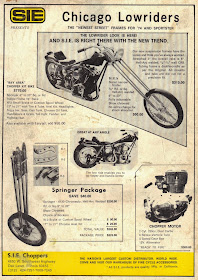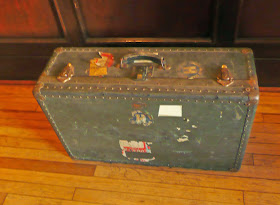About 2700 FTs were manufactured in 1918. This design was very different from the British rolling fortress concept and with the guns mounted in a rotating turret, provided the pattern for modern tank design.
Thursday, April 30, 2015
Schooner Lucia A. Simpson
Built by Rand and Burger at Manitowoc, Wisconsin in 1875, the Lucia A. Simpson was a Great Lakes schooner that spent most of her life carrying lumber. After the turn of the century sailpower quickly disappeared due to steamship competition but she continued working into the thirties and was reputed to be the last schooner in operation on the Great Lakes. She was destroyed in 1935 when she caught fire while laid up at the Sturgeon Bay Shipbuilding Company.
The second stone age
 |
| Edmund Hunter. The Story of Arms and Armour. Ladybird Books Ltd., 1971. Illustrations by Robert Ayton. |
Wednesday, April 29, 2015
We used to make things n this country #192 York Co.
Any information on the York Furniture Co. would be appreciated.
Vanished Makes: Brown-Saltman Furniture Manufacturing Company
 |
| L. Donald Meyers & Richard Demske. Furniture Repair and Refinishing. Reston Publishing Co. Inc. (Prentice-Hall), 1978. |
For a little more information, see The Mid-Century Designs of Brown-Saltman!
Tuesday, April 28, 2015
Velocette 24 hour record
In June 1960 a stock Venom with prototype Vee-Line Avon fairing was pulled off the production line as the bike that would attempt a new 24 hr record. After months of preparation, blueprinting and 1400 miles of highspeed testing, the team set off to Montlhery race track in France for the March 18th attempt. Eight riders participated, and after 24 hrs, they had set a new record for 500s and by default, 750s and 1000s of 3,864.2 km, an average speed of 161.009 kph. The bike was virtually stock ( well-prepared stock!) and the engine produced 39.5 hp for a top speed of 186 kph.
As far as I know that 500cc 24 hr record may still stand. The 750 class record lasted only a week when it was beaten by a team on a BMW R69.
As far as I know that 500cc 24 hr record may still stand. The 750 class record lasted only a week when it was beaten by a team on a BMW R69.
Monday, April 27, 2015
Chopper Motors
I was never much for choppers but the Yamaha TX750 "chopper motor" in the lower right corner caught my eye. The ad is from the Feb. 1976 Motorcycle World magazine, the TX750 was introduced with great fanfare in 1973 only to be immediately panned for problems related to the "Omniphase" balancer system. There was also a exhaust balancing manifold in the front of the head which couldn't have helped engine matters by blocking airflow to the head. Anyways, a couple of years later the bare engines are available as chopper fodder. I wonder if these were a bunch of unsold engines from Yamaha or from unsellable bikes that had been already broken up.
A well travelled steamer trunk
Spartan Air Service Mosquitos
A snapshop found by a friend when he was sorting through the family photos. No other information accompanied it.
Spartan Air services was founded in 1946 in Ottawa to conduct aerial photography and surveying around the world, primarily for the mining and petroleum industries who were then looking for new vistas. Their fleet consisted of Ansons, Venturas, a Lancaster, P-38 Lightnings, Mosquitos, Cansos, DC-3s, Bell 47s and Vertols as well as other smaller aircraft. Their five Mossies were acquired in 1955, after they had been modified for their new role by Derby Aviation in England. They continued in operation into the mid-1960's. Spartan Aero was taken over by Kenting Aviation of Toronto in early 1973.
A google search for "Spartan Air Services Mosquitos" yields lots of interesting sites, including a book project on the company from which I was able to glean most of the information above.
Nicopress Tool
Above, an interesting tool I picked up recently.
"Nicopress" is a trademark of The National Telephone Supply Company, established in Cleveland,Ohio in 1901. They came up with the idea of using swaged sleeves to connect wires, a technique which became very important in the cable-controlled aircraft parts of the era. The company and its products are still a going concern.
 |
| 1939 |
We used to build things in this country, #192 Steam and Diesel locomotives
 |
Donald McQueen and William Thomson; Constructed in Kingston, Canadian Railroad Historical Association Kingston Div. 1999 |
Runbaken Cozycar Heater
Seen at a local swap meet, this little one inch diameter electric heater was intended to be installed in a sidecar to provide a bit of heat for the "lucky"passenger. The Runbaken Magneto company seems to have disappeared by 1932 but I doubt if the anemic charging systems of the day would put out enough to power this plus the lights. And 12 volts?
Sunday, April 26, 2015
Fleet Finch
As I mentioned in a previous post, a friend's uncle took some photos during the Second World War. This is another of them.
Fleet Finches were built by the Fleet Aircraft Company of Fort Erie, Ontario. Production started in 1939, predominantly for use as primary trainers in the British Commonwealth Air Training Plan. During the Second World War, Fleet Canada produced over 160 aircraft per month, the highest production of any Canadian aircraft manufacturer at the time. Founded in 1930, the company ceased aircraft production in 1957, but lives on today as Fleet Canada Inc., an aerospace subcontractor that still carries out manufacturing in Fort Erie.
French munition workers, WWI
Saturday, April 25, 2015
The Allan Steamship Line
The Allen Line lasted almost 100 years as a family business, started by a Captain Alexander Allen in 1819 with a route between Scotland and Montreal. In 1857 under the second generation, the company took over the mail contract from Cunard and became the largest private shipping concern in the world. In 1917 while being run by the third generation of the family, the company was sold to Canadian Pacific and the Allen name disappeared soon after. Ship roster here.
Sydney Harbour Bridge
From A. Gibson. The Commonwealth. Young Learner Books. London: Chatto & Windus, 1965. Illustrated by David Harris.
From the Australian Government website:
"It is reported that in 1943 a flight of 24 RAAF Wirraways flew under the Sydney Harbour Bridge, with one of the pilots changing his flight path at the last moment to go over the top of the Bridge only just clearing it in time.
There is another story of the Americans flying under the Harbour Bridge, with one Kittyhawk flying under in about February 1942 and two Kittyhawks in May 1942. Again in May 1942, the Dutch flew three aircraft of the 18 Squadron NEI-AF under the Bridge in formation and then circled back to do another flight under the Bridge in a single line.
On 22 October 1943, Flight Lieutenant Peter Isaacson and his crew flew the huge Australian Lancaster, Q for Queenie, under the Harbour Bridge during a tour around Australia to raise funds for the war effort."
I can find only one photo of this last event:
 |
| Wikipedia |
As for Q for Queenie, she was eventually stripped for components, used for target practice, and then melted down into ingots.
The Fords and a Model A engine, 1927
Friday, April 24, 2015
Trade with Japan, 1886
 |
The Dominion Annual Register and Review |
The newly completed transcontinental railway established new trade routes with Japan and on July 27 1886, the barque W.B. Flint arrived in Vancouver with 17,430 half-chests of tea which was immediately loaded on a special 10 car train headed east. The tea arrived in Montreal on August 8th and was unloaded in New York two days later. This was the first of a series of seven chartered ships that unloaded their cargo (mostly tea) in Port Moody for this inaugural transcontinental railway freight service. The railway had made trading with the Orient practical.
 |
| City of Vancouver archives |
Part of the tea shipment being unloaded from the W.B. Flint.
The W.B. Flint was built in Bath, Maine in 1885 and was practically new when she made her historic trip from Yokohama to Vancouver. In 1923 she was damaged on a return trip from Alaska and then laid up in Seattle till 1937 when she was burned for scrap.
Gordon Newell, Maritime events of 1936, H.W. McCurdy Marine History of the Pacific Northwest., p. 448.
Memphis Group
Looking at household appliances and furniture in recent years, things have been pretty boring for quite a long time. Time for a Memphis rebirth! More here.
Oil royalties to First Nations
Thursday, April 23, 2015
Pan-American Airways Clipper NC-823M
A black and white photo given to me by a friend. The picture was taken by his uncle who was involved in the South Atlantic air ferry route during World War II. The location of the airfield in the photo is unknown.
Initially named the West Indies Clipper, this Sikorsky S-42 was purchased by Pan-Am Airways in 1934. With 38,000 pounds maximum takeoff weight, it could carry 32 passengers and fly 1200 miles at 150 mph. The S-42 boasted automatic carburetors, propeller brakes and flush riveting and broke all previous world records for speed, range and load. Purchase price was $242,000 (about $4.3 M in today's dollars). Originally used in Latin America, it was renamed the Pan American Clipper for Pacific Survey flights, then renamed the Hong Kong Clipper in 1937. It sank off of Antilla, Cuba in August 1944 following a mishap during takeoff.
The Fanny Bailey
Wednesday, April 22, 2015
Westinghouse Time capsule
At both the 1939 and 1964 New York World's Fairs Westinghouse buried a time capsule intended to be opened in the year 6939, 5000 years in the future. That's optimism!
Someone please let me know if there was anyone there to open them!
Someone please let me know if there was anyone there to open them!
Snail Brand Whitworth wrench
Another "found" wrench in the toolbox. This is a plainer (possibly later?) tool from the company, lacking the nice Snail logo that The Duke posted earlier











































